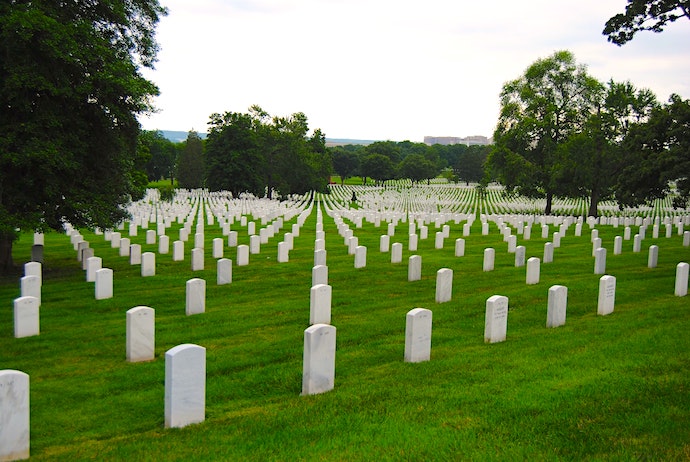In the American ritual calendar, two days celebrate those who’ve served in the armed forces. Memorial Day is poignant, set at the end of May in the context of life’s seasonal burgeoning—flowers, birdsong, sunshine, and backyard barbecues—but dedicated to the memory of those who’ve died in service to the nation. Veterans Day is the less mournful of the two. Known as Armistice Day in much of the world—as it was in America until 1954—it commemorates the cessation of hostilities, the moment when the armistice between Germany and the Allied Forces officially ended World War I. The war to end all wars was over, and peace, it was hoped, might prevail.
And none too soon. The armistice itself went into effect on the 11th hour of the 11th day of the 11th month. The symbolism was lost on no one. By that point, more than 20 million people had died in a war whose most coherent and compelling explanation remains the tragically spiraling momentum of turn-of-the-century industrial technology and nationalistic blundering after power. That it was over was cause for celebration.
That celebration has never been uncomplicated, never altogether unrestrained. As a sort of complement to Memorial Day’s poignancy, Veterans Day falls in darkening days. Its joy was never exultation, but relief: the war is over. Those sent into the thick of it to defend freedoms, ideals, allies, a way of life: they will come home. With a loved one at the front, ideals distill to the sound of an absent voice, the memory of touch. In the context of war, a victory song is always something of a dirge.
America’s National Veterans Day Ceremony embodies this complex emotional tone, of gratitude for the abatement of incomprehensible suffering, and joy in what hasn’t, yet, been lost. Each November 11, it is held at Arlington Cemetery in Virginia, commencing at 11:00 a.m. with the laying of a wreath at the Tomb of the Unknowns, passing through a parade of colors, and closing with comments by a dignitary whose presence is seen to add gravity to an already grave observance.
Those comments are telling; they can be sampled as something of a geological core indicating the state of the nation’s official martial self-understanding. Sixty years ago, having just authorized secret combat operations in Vietnam, President Kennedy prayed “in the name of those who have fought in this nation’s wars” that “there will be no veterans of any further war—not because all shall have perished but because all shall have learned to live together in peace.”
That prayer has gone unanswered. Thirty years later, having months before led the nation into the Gulf Wars that set the stage for today’s global militarization and post-Cold War patriotism, President Bush pressed us to “always remember the importance of preparedness and the high cost of liberty.”
That cost is reckoned daily by veterans and their loved ones, though it remains unknown to the vast majority of the nation’s citizens, who’ve never laid flowers at a veterans cemetery or followed troop deployment numbers. Doing so would not occur to most. Since the end of the draft and the initiation of the All-Volunteer Force in 1973, veterans have not been distributed widely through civilian communities, and Americans have allowed themselves to support the troops in a distant, spectatorial fashion that may signal gratitude or at least political correctness, but also underwrites a thorough cultural ignorance regarding the human costs of war.
Unmediated interaction with the veteran community isn’t for everyone. But it also isn’t the only option, and closing our eyes to the experience of war certainly isn’t the answer. The United States has been at war for over 92% of its national history. The tally of suffering isn’t just immeasurable, it’s inconceivable. The possibility for peace requires, at least, that we face this pervasive reality we’ll never fathom, that we practice the empathy we’ll never perfectly achieve.
Veterans throughout the nation’s history have provided renderings alternative to those of the official record, and what we find in their projects are perspectives that resist pigeonholing. We find the complicated, the messy, the human. The art of Ehren Tool, the literature from Warrior Writers, or community engagement projects like Kelly Carlisle’s Acta Non Verba or Maria Mia Salazar’s Claymore Vets: each of these, and many more, offer the civilian population mediated access to an experiential understanding of the battles waged in their name, and on their dime. They offer living knowledge, not as simple as Captain America or as thrilling as a combat jet flyover, maybe, but reflective of the nation’s global presence and indicative of some of its most pressing domestic failings.
This year’s Veterans Day is dedicated to the centennial commemoration of Arlington Cemetery’s Tomb of the Unknowns. 100 years ago, the tomb was dedicated to “an unknown warrior who in himself represents no section, creed, or race” and “who typifies, moreover, the soul of America and the supreme sacrifice of her heroic dead.” Without the potentially divisive specificities that make a life, that comprise and define the individual dignity of a human whose breath was cut short by a war they did not choose, a war fought on terms they had no say in, these remains were elevated to the uncomplicated status of an ideal.
The Tomb of the Unknowns is guarded around the clock, every day of the year, by silent sentinels whose movements are shot through with significance. Tomb Sentinels are a select few, chosen for precise ritual adherence from those who “answer the sacred call” to perform their “elaborate military ballet” on these “hallowed grounds.” (Visitors are encouraged to join the trolley tours, for about the price of a movie ticket.)
Ideals may profane the real, may draw hearts and minds away from the work to be done and toward a future of dreams, and in so doing they may accustom the suffering to an unjust world. Such has been the secularist critique of a faraway and hoped-for heaven. But like heaven, national ideals give a diverse populace a shared moral horizon. They give people something to believe in.
In his seminal work on the origin and development of nationalism, Benedict Anderson claimed that “No more arresting emblems of the modern culture of nationalism exist than cenotaphs and tombs of Unknown Soldiers.” It is there, in the unnamed and unrooted remains, that Americans can fix the shared metonym for the country they wish they were.
When President Obama addressed the reverential crowd gathered at Arlington in 2011, he echoed Thomas Paine’s singularly compelling conditional vow—“If there must be trouble, let it be in my day, that my child may have peace”—positioning veterans as inheritors of that Revolutionary pledge, as those who “fight so our children won’t have to.” (What does it tell us that Paine had no children?)
This myth of redemptive violence runs through American history, through the stories that we tell ourselves about ourselves, and through the stories our children consume in books and on screens. It allows us to believe unreflectively that peace might be made through war, and that service in war elevates those who serve. The myth does not—because it cannot—integrate the realities of broken bodies and injured souls. It is a myth that feeds off of the increasing alienation of the military from civilian communities, to the detriment of both, and to the diminishment of the national faith it pretends to uphold.
This Veterans Day, commemorating the Tomb of the Unknowns, we might commit ourselves to an authentic engagement with the 19 million veterans now alive in America. This Veterans Day, at the ostensible close of America’s longest war to date, we might commit ourselves to getting to know the 4.5 million American veterans who have served since 9/11, 40% of whom live with a certified, service-connected disability.
“Thank you for your service”—America’s current public piety of choice—is insufficient to the task. It smacks of the obligatory and it leaves the person on the receiving end unknown, their service reified and past-tense. It’s time to leaven that ritual platitude with some authentic civic reflection, some historical and situational awareness, and some active engagement with the veterans whose lives, purpose, continued service, and individual dignity are increasingly isolated from the civilian communities who nonetheless broadcast their support via bumper stickers, political slogans, and other relatively low-effort and low-impact gestures.
If we do that, we might know what it is to practice the support we proclaim. If we do that, our ritual proclamations might do more than ease the conscience and subsidize the comfort of a willfully ignorant citizenry at the peak of global power. If we do that, we might stop sacrificing those who serve, on the idealized altar of a superficial American Civil Religion. If we do that, we might just set ourselves on the path to less war.
This Veterans Day, let’s go ahead and idealize the Entombed Unknowns. But let’s enflesh that ideal by getting to know our veterans.





